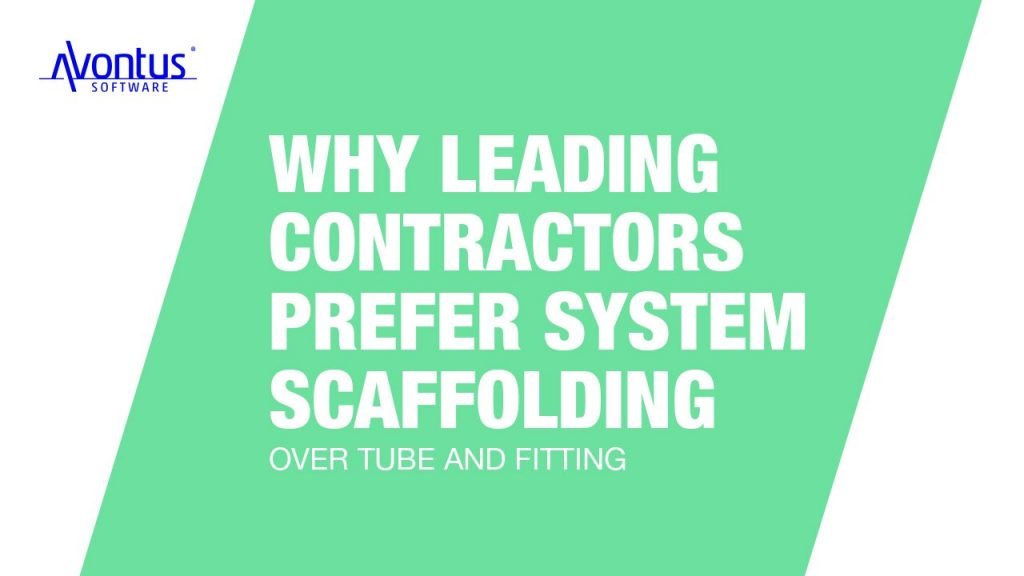System Scaffolding Is Here for Good: Ease Your Transition into It
Scaffolds are generally quite unassuming. When people walked past the construction of Burj Khalifa, we doubt they were admiring the… Read More
FREE Avontus Designer trial! Full access to all the features. Find out more

There are many types of scaffolding. The tried-and-true scaffolding in certain countries like the UK is, of course, tube and fitting. It’s what many scaffolding businesses start out with. But more contractors are switching to the next generation of scaffolding — system scaffolding.
It’s not a switch that’s taken lightly. The type of scaffolding you choose can have an enormous impact on a project. Many contractors have found that making the wrong choice is a costly affair, resulting in expensive waste and delays.
In this article, we present a breakdown of each type of scaffolding. We will compare and contrast them against seven factors so you can see for yourself why more contractors prefer system scaffolding over tube and fitting.
Tube and fitting scaffolding, also known as tube and clamp or tube and coupler, is a basic type of scaffold that comprises just steel or aluminum tubes, boards, and clamps. While the tubes are clamped together in whatever configuration is needed, tube and fitting scaffolding is deceptively simple—an extensive amount of knowledge and skill is required to safely erect and dismantle these scaffolds, and even small structures can require intricate designs and highly skilled builders.
System scaffolding, sometimes called modular scaffolding, comprises prefabricated and pre-engineered horizontal, vertical, and diagonal components all made to interlock together like a jigsaw puzzle. There are several types, used in various parts of the world, such as Kwikstage, Ringlock, and Cuplock scaffolding.
Tube and fitting often requires highly skilled workers who are knowledgeable and experienced at clamping the tubes together and inspecting the structure. This results in the need for a much higher level of training, especially for the more complex and odd-shaped configurations.
System scaffolding, on the other hand, is designed for easier erection. Each part has a specific function that informs how they fit together, needing far less creativity and supervision to assemble a scaffold. If experienced tube and fitting erectors are unavailable, the best bet is to rely on system scaffolding.
Tube and fitting scaffolding generally takes longer to assemble and dismantle with more components and specialized labor involved. If specialized labor is not readily available, further delays can occur.
System scaffolding needs far less time to set up with parts conveniently connecting together. This allows projects to proceed much quicker.
A key benefit of tube and fitting is thought to be its flexibility in terms of configuration. It can fit closely around odd-shaped angles and more inaccessible areas.
System scaffolding has fixed sizes, heights, and forms, making it less adaptable to the needs of a project. However, system scaffolding offers a wide variety of components, all but nullifying the versatility advantage of tube and fitting. In addition, many types of system scaffolding have special pre-designed components like lattice girders, roofing systems, and frame guardrails, offering workers increased speed and safety.
The design of tube and fitting has not changed much over the years. It’s a testament to its versatility. Nonetheless, as projects become more complex, this has led to improvised solutions that don’t exactly meet the project requirements. It’s not uncommon for projects to borrow system scaffolding components (such as stair towers) to address shortcomings of pure tube-and-fitting structures.
System scaffolding is constantly evolving to keep up with new project requirements. System scaffolding designers regularly release new purpose-designed components to solve growing jobsite problems and project needs.
Tube and fitting scaffolding can generally support heavy loads and is good enough for most jobs. As loads increase, the tube and fitting strategy is generally to throw more tubes at the problem, further increasing labor costs and erection times.
However, some system scaffoldings are equipped to handle much heavier loads, depending on which system you choose. This typically allows system scaffolding to be more efficient for projects that demand taller or heavier-duty scaffolds.
With many smaller parts like clamps and couplers to keep track of, tube and fitting scaffolding projects often wind up with losses from missing parts, which necessitate replacement. While tubes and couplers are individually fairly cheap, widespread losses can lead to a lack of interest in managing the asset, resulting in runaway equipment costs.
The uniqueness and higher individual value of system scaffolding components encourages equipment stewardship and makes equipment tracking easier and more accountable. This is especially true if you are using asset management software like Avontus Quantify®. You can monitor your system scaffolding inventory and have thorough visibility into its condition, availability, and location. This facilitates greater levels of control and accountability in your inventory.
Commonly available, tube and fitting scaffolding parts are a less costly investment—if your only concern is the cost of the gear itself.
But with system scaffolding, labor costs—both in terms of hours and necessary training —are greatly reduced. In other words, the cost is more transparent and more manageable. In fact, for many projects, system scaffolding works out to be more cost-effective, at least for basing out the structure if not for the entire scaffold.
Whether you choose system scaffolding or tube and fitting, you could always use a scaffolding design software that makes planning simpler. That’s exactly what Avontus Designer® does.
Just import a plan, add scaffolds wherever you want them, and walk through it in 3D. The scaffolding design software can combine system scaffolding designs from a dozen manufacturers including Ringlock, Cuplock, HAKI, Safway, and OCTO.
It can even integrate tube and fitting for odd bays, returns, cantilevers, and other enhancements to system scaffolds. Avontus Designer automatically creates a bill of materials so you’ll know exactly what you need to turn the idea into reality.
Check out the link below to learn more about Avontus Designer.